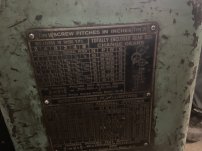Welderwill
Plastic
- Joined
- Aug 24, 2016
Hello fellow machinists, need a bit of advice concerning a DSG lathe I’m offered for a bit of machining as payment, current owners have no idea about it, was left on site when they bought the property said it’s probably hasn’t run for 10 to 15 years was always inside in a warm shop, it’s a type 18, seems to me there not too much noise online about the type 18 DSG, it looks fairly rough and dirty where it’s sitting now not sure of condition looked at it once and I noticed there was a fair amount of play in cross slide and compound screws, everything seemed to be moving freely I never checked anything machine is under power I’m going there again soon to evaluate condition bed wear and so on, I understand the last guy to operate it yes and old gentleman that is in ailing health and said it worked fine when he used to 15 years ago, it is basically just about free so I need to decide if I’m interested must have around 9 to 10,000 pounds, bed seemed around 8 feet, my biggest concern is bad wear and top slide wear;how much is too much?? Can anyone comment on how old this machine is,will post a few pictures of what I do have so far the machine has a four jaw, three jaw , taper attachment, steady, follow rest and a bit of tooling
Attachments
-
 1281D08B-4485-4009-9DF8-1D77598E2693.jpeg1.6 MB · Views: 104
1281D08B-4485-4009-9DF8-1D77598E2693.jpeg1.6 MB · Views: 104 -
 71A635FE-841C-47CD-8CF1-EEB7B26C981D.jpeg4.5 MB · Views: 107
71A635FE-841C-47CD-8CF1-EEB7B26C981D.jpeg4.5 MB · Views: 107 -
 1A62AA4C-A025-492F-B18A-21C1964AD2CF.jpeg2.4 MB · Views: 103
1A62AA4C-A025-492F-B18A-21C1964AD2CF.jpeg2.4 MB · Views: 103 -
 5DD2DBE9-7ED9-4279-98C1-FA85B6ECBD29.jpeg3.5 MB · Views: 106
5DD2DBE9-7ED9-4279-98C1-FA85B6ECBD29.jpeg3.5 MB · Views: 106 -
 004D02A1-67D2-429E-9ABD-D3A50608A823.jpeg4.5 MB · Views: 99
004D02A1-67D2-429E-9ABD-D3A50608A823.jpeg4.5 MB · Views: 99 -
 B43104CE-1817-4607-926C-9BA4A5739053.jpeg2.6 MB · Views: 102
B43104CE-1817-4607-926C-9BA4A5739053.jpeg2.6 MB · Views: 102

